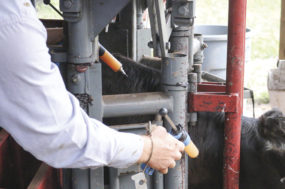Teat dips are complex chemical formulas and all the ingredients hang in a delicate balance. The correct amounts of each ingredient are important to keep the teat dip stable, effective and safe to use on your cows’ teats. In my article, which can be found by clicking here, I discussed popular germicides often found in teat dips. Germicides, however, are just one aspect of teat dip chemistry. There are many other aspects to formulating a good teat dip.
Besides the germicide, the other ingredient listed by percentage on a teat dip label is the emollients, or skin conditioners. Sometimes the actual emollient is listed – sometimes it is not. The last thing listed is the “inert” ingredients.
The inert ingredients include pH buffers, surfactants, wetting agents, colorants and thickeners. These ingredients are vital to the formulation and are often proprietary information. We will talk more about those ingredients later. First, let’s take a closer look at skin conditioners.
There are several different options available for skin conditioners and they fall into three classes. These classes are emollients, humectants and superfatting agents. An emollient is a softening agent that smooths the skin. A humectant actually draws in moisture from the surrounding air to keep the skin moist.
Superfatting agents are a skin conditioner that can replace the lipids (fats) in the skin that were removed from the skin by the detergents (surfactants). Fat is an important component in the dermis (skin). The fat or oil in the skin helps to keep it smooth and soft and provides a barrier against foreign substances and bacteria.
Another important aspect of skin conditioning is exfoliation. Exfoliation removes the oldest dead skin cells on the skin’s outermost surface. Exfoliation can be important in a herd that has dry, rough teat ends. The cracks and crevices in rough surfaces give mastitis-causing bacteria a place to hide and multiply.
The most common ingredient we see used as an emollient in teat dip is glycerin. This is because glycerin is efficacious, fairly inexpensive and readily available. Glycerin is an emollient, humectant and a superfatting ingredient. Glycerin is the only commonly used skin conditioning ingredient that exhibits all three of these properties. Glycerin does not exfoliate, however.
Aloe is a soothing skin conditioner that is an emollient and a humectant. Aloe is present in many dips on the market. Aloe is usually used in small amounts because it is very expensive. If you find an inexpensive dip on the market that claims to have high levels of aloe in it, you should be wary.
Polyethylene glycol, propylene glycol and sorbitol are all emollients and humectants as well. These skin conditioners are found in various teat dips on the market. Propylene glycol is common in teat dips formulated specifically for cold weather because of its ability to resist freezing and keep liquids less viscous, even in very cold temperatures.
Unfortunately, there are some emollients, such as mineral oil, that can actually “tie up” an active ingredient and make the teat dip less efficacious.
There are several fatty acid esters used in teat dips. These have various different names. They are all emollients and superfatting agents. Lanolin is an example of an emollient and superfatting agent. However, it is important to note that lanolin is not soluble in water. It therefore must be complexed with polyethylene glycol to become water-soluble.
As I mentioned earlier, exfoliation can also be an important factor to consider. An ingredient we commonly see in teat dips that has shown efficacy at sloughing away dead skin cells is lactic acid. Lactic acid can slough off dead skin cells and also help remove hyperkeratosis (the “buds” that form at the end of the teat, which are actually keratin from inside the teat canal).
I must note, however, that hyperkeratosis most likely indicates a problem with the settings in your milking equipment and not solely a sign that you should try a different teat dip.
Lactic acid is also unique in that it does have some antimicrobial properties. Therefore, some manufacturers list it as an active germicide. Some list it as a skin conditioner. Neither is really right or wrong, but it is important to note that lactic acid is not a particularly strong germicide and should probably be used in conjunction with another germicide.
Let’s discuss the “inert” ingredients now. Although these ingredients never receive much attention, they are just as important as the germicide and the skin conditioners in a teat dip. These are the ingredients that keep everything in suspension and keep the pH in the desired range, amongst other things.
Buffers are used to “buffer” the pH. The pH of a teat dip can greatly affect teat end health. A dip that is too acidic or alkaline can damage the teats. The pH is also an important aspect in keeping the germicide efficacious.
Most iodine dips have a pH buffered somewhere between 3.5 to 5.5, while chlorhexidine tends to be higher, which is fine because the cow’s teat has a natural pH of approximately 7 (neutral). Common buffering agents are organic acids and the salts of these acids, such as citric acid, lactic acid, acetic acids, etc.
Surfactants are added to teat dips to solubilize and stabilize the ingredients in the dip and increase the ability of the teat dip to clean the teat. They suspend soil and help to remove it from the teat.
They do this by reducing the surface tension of the liquid in the teat dip, which helps the ingredients in the dip have greater contact with the skin on the teat. Surfactants are also responsible for the foam a dip makes when a foamer is used. Common surfactants include ethoxylated alcohols, soaps and many other chemical compounds whose names won’t fit in this article.
Besides buffers and surfactants, dips also contain compounds to alter their viscosity and color. Post-dips tend to be thicker so they will cling to the teat longer and provide longer-lasting protection. Dips that are applied through sprayer systems need to be thinner so they do not clog the hoses and sprayers. Natural gums and some synthetic thickeners are used to achieve the desired viscosity of a dip.
Coloring agents such as FD&C dyes are sometimes added so the owner/milker/parlor manager can better see that the cows have been dipped and the dip is covering the appropriate amount of the teat. I should note that the Food and Drug Administration (FDA) discourages the use of colorants and/or dyes in iodine teat dips because they can result in false readings when testing the iodine for actual strength.
It is important to remember that whatever is added to a teat dip can affect the delicate balance of the formula. No one should alter the formula beyond label directions. Adding the wrong thing in the wrong amount can make the teat dip completely ineffective.
Additionally, we must remember teat dips are classified as a drug by the FDA. Altering a drug is a violation of federal law. Because teat end health is a major factor in preventing mastitis, it is important you choose the right dip.
The concentrations of emollients can vary from zero percent to upwards of 70 percent. Most pre-dips do contain some kind of skin conditioner, although it is usually a smaller amount. Higher levels of skin conditioners are more common in post-dips.
The ultimate objective is to find the teat dip that is appropriate for your herd. It is important to teat end score your cows or do your best to evaluate the condition of their teats. If you notice cracks, chapping and/or hyperkeratosis, switching dips to a higher concentration of skin conditioners or that contain exfoliating agents may help alleviate those issues.
Again, I must stress that switching teat dips may not solve the entire problem. Your milking equipment should be thoroughly evaluated as well.
Remember that iodine (or any other active germicide for that matter) and skin conditioners alone cannot make an effective teat dip. The other components of the dip are just as important. Saving money on a cheap teat dip will cost you money in the long run if it damages your cows’ teats or doesn’t kill mastitis-causing bacteria effectively. Your cows are your biggest asset and must be treated as such. PD







